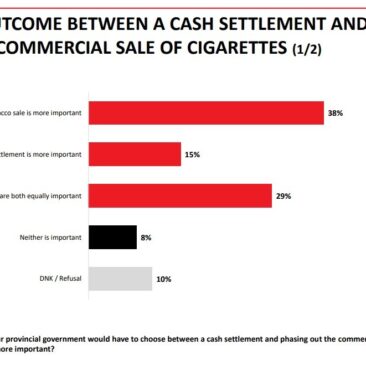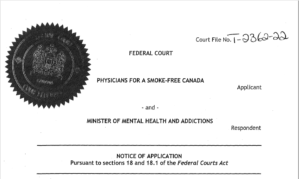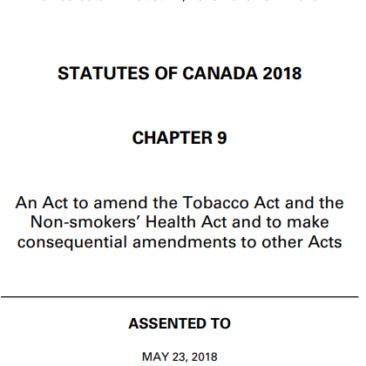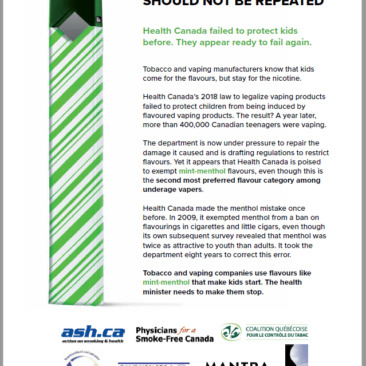Last spring the federal Privy Council Office (the department which serves the Prime Minister and Cabinet) commissioned a series of focus groups across Canada to gain information on a number of topical issues. The topics ranged greatly, with Canadians being asked for their input on possible names for national pharmacare and climate plans, to their views on steel tariffs and pipelines.
Although the focus groups were held in April, May and June, the results were only recently released. They were prepared by Phoenix Strategic Perspectives under the title “Spring 2019 Focus Groups” POR 139-18 and are available in three separate reports on the National Library
One topic put to the last cycle of focus groups in June related to vaping products and smoking. The conclusions from this report are reproduced below.
6. Vaping and Smoking
Issues in this section were explored with participants in Surrey, Fredericton, Sorel, and Belleville.
Smoking and vaping status
Most groups included a mix of smokers (daily and/or occasional smokers) and non-smokers. The exceptions were the group of women in Fredericton and homeowners in Surrey, all of whom were non-smokers. Among those who are non-smokers, many are former smokers. At least a few participants in most groups said they have tried vaping.
Experience and familiarity with vaping
Those who have tried vaping said they did so either out of curiosity, typically in a social setting (e.g. with friends), in order to try to quit smoking, or in order to try to reduce stress. A few added that they believe vaping is expensive and/or more expensive than smoking cigarettes. Those who have not tried vaping identified the following as things they feel they know or have heard about it:
- it is very popular among youth (i.e. trendy)/considered ‘cool’;
- there is a lack of knowledge about its long-term health effects;
- the vaping liquids come in a variety of flavours;
- one can vape with or without nicotine;
- smokers use it as a way to quit smoking;
- one can strengthen or weaken the intensity or dose of what is inhaled;
- it is not regulated/not as regulated as cigarettes;
- it has been linked to the condition known commonly as ‘popcorn lung’ (bronchiolitis obliterans);
- some vaping devices have exploded;
- big tobacco companies are involved in it;
- it looks silly;
- it is a gateway towards smoking;
- it is addictive; and
- it smells good.
Sources of information about vaping
Participants have learned about vaping from various sources which include the following:
- relatives/friends and acquaintances;
- social media;
- internet;
- news;
- seeing people vaping;
- vape shops (identified by some as increasing in number in their neighbourhoods); and
- advertising.
Perceived benefits and harms of vaping
Perceived benefits or potential benefits of vaping included the following:
- it can/might help people quit smoking;
- it may prevent young people from starting to smoke (i.e. an alternative to smoking);
- it is not as bad for one’s health as smoking/contains fewer chemicals than cigarettes;
- it does not smell bad/make one’s clothes smell bad;
- it does not create second-hand smoke; and
- the proliferation of vape shops creates employment.
Some said they could think of no benefits to vaping, while some others said they did not know or did not know enough about vaping to offer an opinion.
The most commonly identified harm or potential harm associated with vaping was lack of knowledge/studies about its possible long-term health effects. Other harms associated with vaping included the impression that it was a gateway/pathway to smoking for youth, the danger posed by exploding devices, and the possibility of becoming addicted to it.
Participants tended to express uncertainty when asked about the health effects of vaping, and specifically the harmfulness of vaping compared to smoking tobacco cigarettes. This uncertainty was based on the previously mentioned widespread impression that there is a lack of knowledge/studies about the long-term health effects of vaping. Having said that, the uncertainty in question was often related to how harmful vaping is, not to whether vaping is harmful at all. Indeed, there was a relatively widespread impression that vaping is probably not good for one’s health, even though it is as yet unclear what the health impacts are, and even though it might not be as bad as smoking.
Participants made the following points in this regard:
- vaping liquids contain chemicals, and inhaling these chemicals into one’s lungs cannot be good for one’s health;
- inhaling any kind of smoke (whether produced by cigarettes or vaping devices) is not good for one’s health;
- vaping with nicotine is no better than smoking a cigarette; and
- vaping may not be as harmful as smoking, but this could result in people vaping more frequently because they think it is not harmful to them, and this increased frequency of vaping could result in negative health effects or addiction.
Some participants were more categorical, suggesting that vaping is harmful (pointing to reports that vaping can cause conditions such as popcorn lung and water on the lungs) and/or dangerous (pointing to reports of malfunctioning of devices resulting in explosions).
Finally, some participants did suggest that in their opinion vaping is less harmful than smoking, but it was also observed that this does not mean that vaping is not harmful simply because it is less harmful than smoking.
Perceptions of smoking
Most participants in these locations interact with people who smoke. This includes friends, relatives, and colleagues, and the frequency of interaction ranges from rarely, to occasionally, to frequently (e.g. daily). Asked how they feel when people in their social circle smoke in their presence, most said they do not like it, with some going so far as to say they hate it. Other feelings elicited by people in their social circle smoking in their presence included disappointment, and a ‘live and let live’ attitude.
Reasons for critical or negative reactions to people smoking in their presence included the following: the smell of cigarettes, the odor it leaves in their clothes/feeling dirty, not wanting to be exposed to second-hand smoke/health concerns, difficulty breathing, allergies being triggered, the temptation to smoke themselves, not wanting their children exposed to smoking/smokers, and difficulty understanding how people can continue smoking given the dangers it poses to health. Participants who expressed a ‘live and let live’ attitude towards those smoking in their presence sometimes added that people in their circle who smoke do so outdoors (i.e. not in proximity to them in an enclosed space).
Perceptions of smoking as a health issue today
There was near unanimity among participants that smoking is a big health issue today. Reasons for this opinion included the following:
- the effects of smoking have not changed, and illnesses caused by/linked to smoking remain with us (e.g. cancer, emphysema). Related to this was the impression that many smokers and even former smokers are only now beginning to experience the health effects of years of smoking;
- dangers posed by smoking affect not only smokers but non-smokers (i.e. second-hand smoke);
- health care costs associated with smoking-related illnesses/the strain it poses on health care resources;
- smoking is an addiction and should be treated as an illness not just a “bad habit”;
- the impact it has on the more vulnerable members of society (i.e. lower income Canadians are more likely to smoke but least likely to be able to afford the smoking cessation devices that might work);
- youth/young people continue to smoke despite health warnings and scientific evidence of its impact on heath;
- the environmental impact of smoking (e.g. cigarette butts and chemicals that remain in smoked cigarettes); and
- smoking/having smoked can adversely affect one’s insurance/insurance premiums.
Some participants added that smoking is an important issue to them personally, mainly because of personal health issues/concerns (e.g. asthma, allergies, effects of second-hand smoke) and/or because of the impact it has on relatives/loved ones (e.g. cancer).
While there was near unanimity that smoking is a big health issue today, there were differences of opinion about whether the health risks to Canadians generally that is posed by tobacco has increased, decreased or remained about the same over the past five years. Participants tended to be divided between those who think the risk has decreased and those who think it is about the same.
Reasons for the impression that the health risk has decreased tended to be variations on the assumption that the proportion of smokers has been decreasing over time. This decrease was ascribed to various factors which included the following:
- the increased cost of cigarettes;
- greater awareness of the heath effects of smoking, especially among the young;
- smoking is no longer socially acceptable and no longer seen as ‘cool’;
- more and more people are quitting smoking as a result of successful cessation devices; and
- more and more people are turning from smoking to vaping.
Participants who think the risk posed by smoking is about the same as it was 5 years ago provided the following reasons to explain their point of view:
- they have not noticed any changes over the past 5 years in either health warnings or legislation related to cigarettes (which they noted have been in place for decades);
- youth/young people continue to smoke despite health warnings and scientific evidence of its impact on heath;
- people can still be seen smoking in public places (e.g. on work breaks); and
- the risks posed by tobacco are similar for vaping, which is on the rise and appears to be supported by investment from the tobacco industry.
A few participants think the think the health risk posed by smoking may have increased compared to five years ago. Two reasons were given to explain why. One was the impression that the effects of smoking on health can take years to manifest themselves, the result being that more people may now be suffering from the effects of smoking than was the case five years ago. The other was the impression that e-cigarettes (viewed as a form of smoking) that contain nicotine can deliver higher concentrations of nicotine than regular cigarettes.
Impressions of smoking regulations and social acceptability of smoking
Participants were asked for their impressions of the opinion that smoking regulations have gone too far, and that those who smoke have no rights at all. The widespread impression among participants was that this was not the case. That being said, there was also a widespread impression that smoking is not (or no longer) socially acceptable. Reasons for this impression included the social censure that smokers often encounter (e.g. negative perceptions in general, ‘dirty looks’, critical comments), legislation limiting where smokers can smoke, and the impression that because smoking is harmful, non-smokers have a right to be protected from its effects. Participants who think it is socially acceptable to smoke, primarily men in Sorel, were of the opinion that there is a ‘live and let live’ attitude that still prevails when it comes to smoking and that smokers and non-smokers have reached a modus vivendi.
Impressions of smokers
Most participants said they have a ‘live and let live’ attitude when it comes to smokers, some adding that people have a right to take decisions regarding their own lives as long as it does not interfere with the rights of others. In some instances, participants said their feelings towards smokers vary by age. Specifically, some said they feel disappointment when they see younger people smoking or think that it is stupid for young people to start smoking given all that is known about the health effects of smoking. A few participants said they feel bad for smokers because smokers are often among the more vulnerable members of society (e.g. lower income, less formal education). Participants said their impressions about smokers have not changed considerably in the last 5-10 years. One participant said his impression of smokers changed over this period of time, specifying that after graduating from high school he no longer considered smoking ‘cool’.
Reaction to the statement that that those who smoke could quit if they really wanted to elicited nuanced reactions. There was a widespread impression that people have to really want to quit smoking in order to be successful. In other words, the decision to quit has to be a personal decision and the person in question has to be motivated. At the same time there was also widespread recognition that quitting is not as easy as simply taking the decision to do so, and that various factors come into play. For example, it was observed that smoking is an addiction, that many people need help to break the addiction (e.g. moral support, cessation resources), and that it may take numerous quit attempts before someone is successful.
Perceptions of smoking as a government priority
Most participants overestimated the percentage of the Canadian population aged 15 and older that smokes today (either daily or occasionally). [8] Participants were then read the following statement and asked for their reaction:
Some people say that smoking rates in Canada are decreasing and public focus should now be on other issues such as other health care issues, climate change or balancing the budget. Others say that there are still 4.6 million smokers in Canada and so tobacco should continue to be a high priority. From your own point of view, should tobacco continue to be a high government priority?
Participants were divided in their opinions, though most felt that the public focus should now be on other issues. Reasons given included the following:
- enough has been done in this regard/efforts have been successful, and much has been achieved (e.g. smoking rates are declining, 15 percent of the population smoking is a good result/acceptable proportion, smoking will never be eliminated completely as long as it is legal);
- public awareness of the hazards of smoking is now widespread and generally accepted; and
- other important issues need to be addressed (e.g. opioids, the environment).
Those who think tobacco should continue to be a high priority observed the following:
- young people continue to start smoking, despite all the information and evidence about the hazards of smoking;
- smoking has important environmental consequences that should be addressed;
- the health-related consequences of smoking will still be with us for years (e.g. cancer rates among smokers); and
- a 15 percent smoking rate can realistically be reduced further (i.e. more progress can still be made).
Ways to help Canadians quit using tobacco products
Participants were informed that Canada’s Tobacco Strategy has committed to reducing tobacco use to 5 percent by 2035 and asked how the Government of Canada/Health Canada could best help Canadians quit using tobacco products, to meet this objective. The most frequently made suggestion in this regard was to subsidize/reduce the cost of smoking cessation resources/strategies (e.g. prescription medications). Other suggestions included the following:
- raise the price of cigarettes;
- prohibit smoking altogether;
- focus on rewarding quitters (e.g. competitions with prizes);
- focus information campaigns on positive sides of quitting/success stories (i.e. as opposed to scare tactics);
- focus efforts on young/youth smokers;
- promote non-smoking among new immigrant/new Canadian communities; and
- restrict the sale of cigarettes to specialty shops.
Some participants in Belleville suggested addressing laws that facilitate access to cigarettes in certain circumstances, such as the selling of cigarettes on reserves.











